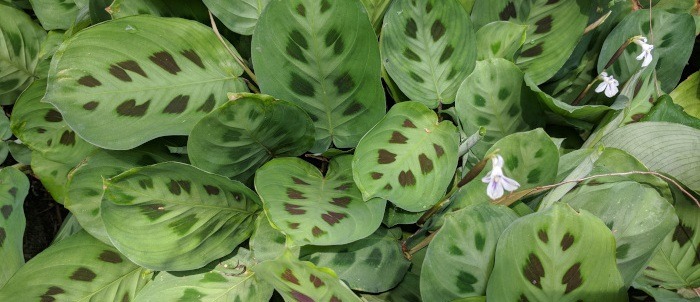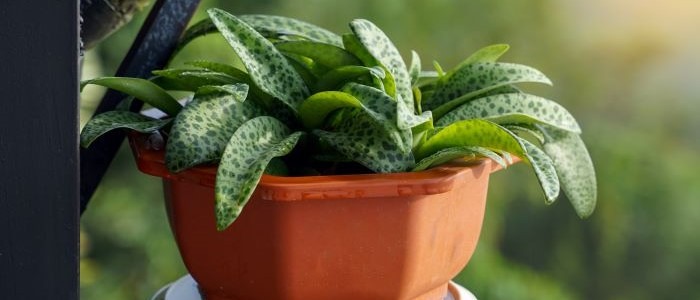Monstera Thai Constellation is an evergreen tropical plant that is native to Southeast Asia, and has become increasingly popular as a house plant. Its glossy foliage can be arranged in a variety of ways, making it a great addition to any home. The plant prefers bright indirect light and evenly moist soil, making it easy to care for indoors or outdoors.
Monstera Thai Constellation is known for its large, glossy leaves with characteristic white markings. It can be trained to climb or hang, making it perfect for both hanging baskets and potted plants. Pruning and propagation are also highly tolerated by the plant, meaning you can easily shape your Monstera Thai Constellation into whatever design you’d like!
The Monstera Thai Constellation requires minimal attention to stay healthy and vibrant. To keep your plant looking its best, water when the top layer of soil feels dry and fertilize every two weeks during the growing season. In terms of humidity levels, the plant prefers high humidity but won’t suffer if kept at normal household levels – just make sure not to overwater!
With this guide, readers will be able to confidently cultivate and maintain their Monstera Thai Constellation for years to come! With proper care and maintenance, you’ll be able enjoy your beautiful Monstera Thai Constellation from day one until long after you’ve welcomed it into your home.

Monstera Thai Constellation Frequently Asked Questions
Is the monstera thai constellation difficult to propagate?
Yes, the monstera thai constellation can be challenging to propagate compared to other monstera varieties. This is because it is a relatively new hybrid plant and its unique variegation pattern makes it more susceptible to stress and damage during propagation. Additionally, the demand for this rare and sought-after plant has resulted in limited availability, making it even harder to obtain cuttings for propagation.
What are the light requirements for monstera thai constellation?
Monstera Thai Constellation is a tropical plant that thrives in bright, indirect light. It prefers a well-lit room with filtered sunlight, as direct sunlight can scorch its leaves. However, it can tolerate slightly lower light conditions, although this may result in slower growth and smaller leaves. Overall, providing ample bright, indirect light will ensure the best health and aesthetics for this stunning plant.
Light Requirements for Monstera Thai Constellation
Light is essential for the growth and health of Monstera Thai Constellation, and it should be provided in the form of bright, indirect sunlight. To avoid sunburns, direct sunlight should be avoided and the plant should be rotated every few weeks to ensure even light distribution. If natural light is limited, supplemental lighting in the form of LED or fluorescent grow lights can be used to provide the necessary light for the plant.
When using supplemental lighting, it is important to make sure that your Monstera Thai Constellation receives at least 8-12 hours of indirect sunlight every day. The ideal location for this type of lighting would be on a windowsill or other area near a window where natural light can also reach your plant. Additionally, if possible, move your Monstera Thai Constellation around during its growing season as often as you can so that all parts of its foliage get equal amounts of sunlight.
Additionally, too much light can also cause damage to your Monstera Thai Constellation’s leaves; keep an eye out for yellow patches or burn marks when moving your plant around during its growing season. If you notice any signs of distress due to excessive exposure to direct sunlight, move your plant away from that area or provide more shade with curtains or blinds if needed.
Finally, some varieties of Monstera Thai Constellation prefer lower levels of light than others; look up information about your specific variety before deciding how much supplemental lighting to provide for your plant. By following these simple steps and providing adequate but not excessive levels of light for your Monstera Thai Constellation you will help ensure healthy growth and beautiful foliage.
Monstera Thai Constellation Soil Requirements
Monstera Thai Constellation requires a soil mix that is both well-draining and able to retain moisture. This soil should include a combination of peat moss, perlite, and vermiculite, as well as a generous amount of organic matter like compost or aged manure. The soil should also have a pH level between 5.5 and 6.5, which will help the plant absorb nutrients from the soil more easily. It is important to check the moisture levels before watering to prevent root rot and other issues caused by over-watering.
Repotting Monstera Thai Constellation every two years can be beneficial in maintaining optimal growing conditions as it helps ensure that the soil is fresh and nutrient-rich. When repotting your Monstera Thai Constellation, use a pot with drainage holes at the bottom, as this will help prevent any waterlogging issues that could lead to root rot or other problems. Also, make sure that you are using fresh potting soil for each repotting session as this will provide an ideal medium for your plant’s roots to take hold in.
Finally, it is important to note that Monstera Thai Constellations do not do well in soggy soils so make sure you are not overwatering them nor allowing them to sit in standing water for long periods of time – this can lead to root rot or other issues with their health. With these guidelines, readers will be able to create the perfect environment for their Monstera Thai Constellation to thrive.
Watering and humidity for Monstera Thai Constellation
Caring for Monstera Thai Constellation requires attention to watering and humidity. To achieve the best results, regular hydration is a must; however, you must take care not to over-water your plant as root rot or other issues may arise. The amount of water needed depends on the size of the pot and climate conditions; typically, 10-14 days between waterings should suffice.
For optimal growth, maintaining a relative humidity level of 50%-70% is key. To accomplish this, misting with distilled water or using a humidifier can be effective approaches. When you do water your Monstera Thai Constellation make sure to target its base as moisture accumulation on leaves can cause fungal diseases. Additionally, avoid watering during midday heat as it will simply evaporate before your plant has time to benefit from it.
It’s important to pay attention for signs that your Monstera Thai Constellation needs more or less frequent watering. If you see yellowed or wilted leaves or dry soil that won’t retain moisture when squeezed these are symptoms of dehydration and require increased hydration frequency. On the other hand, soft brown spots on leaves or roots emerging from drainage holes are indications of overwatering – in this case reducing how often you water is necessary.
By following these guidelines for proper watering and humidity levels combined with appropriate lighting for your Monstera Thai Constellation you can ensure its health and make sure it flourishes!
Monstera Thai Constellation Fertilizing and Repotting
Fertilizing and repotting your Monstera Thai Constellation is an important part of ensuring that it grows healthy and strong. Fertilizer should be used sparingly, as too much can cause the plant to become over-fertilized. It’s best to use a balanced liquid fertilizer with an NPK ratio of 10-10-10 every few weeks during the growing season. Avoid fertilizers with high amounts of nitrogen, as this can lead to weak stems and yellowing leaves.
When it comes to repotting, larger pots are recommended than necessary in order to allow for longer periods between re-potting. Choose a pot with drainage holes at the bottom and fill it up with fresh potting soil—a mix of peat moss, perlite, vermiculite, and organic matter such as compost or aged manure is ideal. Repotting should be done every two years or when roots start growing out of the drainage holes in the bottom of the pot. When re-potting your Monstera Thai Constellation, make sure not to damage any roots while transferring it from one pot to another.
When caring for your Monstera Thai Constellation, it’s important to keep in mind both its fertilization needs and repotting schedule so that you can ensure its long term health and growth. Following these guidelines will help readers successfully grow their Monstera Thai Constellation for years to come!
Pruning, Propagation, and Common Issues
Cultivating Monstera Thai Constellation to its fullest potential requires careful pruning. Utilizing a pair of sterilized scissors, snip away any dead or dying leaves; leave enough stem attached so the leaf can grow back. When necessary, typically in the spring and summer months when growth is most active, make sure to prune your plant.
Propagating this species has multiple options available such as water propagation, soil propagation, air layering and division. With water propagation take a cutting from the plant and let it root in a jar of water before transferring to soil. Soil propagation entails taking a cutting directly into soil where it will form roots then potting up.
Air layering involves removing a section of stem with leaves still attached at the base of the plant then applying rooting hormone onto the wound before wrapping with sphagnum moss and plastic wrap until new roots form. Division splits up the rootball into several pieces with each one having at least one stem attached prior to planting separately in individual pots.
It’s common for Monstera Thai Constellation to experience brown spots on leaves due to too much direct light or overwatering; yellowing of leaves due to lack of light or nutrients; dehydration because of insufficient watering; and root rot caused by overwatering or inadequate drainage in containers. To restore healthiness to an unwell monstera thai constellation check for pests or disease using ultraviolet flashlight inspection if needed; adjust environmental conditions such as proper light levels and humidity levels; as well following these steps readers can keep their Monstera thai constellation healthy for many years!
Conclusion
In this final section of the blog post, we will take a look at the key takeaways of caring for and growing Monstera Thai Constellation. First and foremost, it is important to provide your plant with plenty of bright, indirect sunlight and a well-draining soil mix that contains peat moss, perlite, vermiculite, and organic matter.
Additionally, regular hydration is necessary but should be done carefully to avoid over-watering. Fertilizing with a balanced liquid fertilizer every few weeks during the growing season can help promote healthy growth. Finally, pruning should be done with sterilized scissors and propagation can be done through water, soil, air layering or division.
Monstera Thai Constellation plants are relatively low maintenance and can be easily cared for if given the right environment. By following these guidelines readers can create an ideal environment for their Monstera Thai Constellation to thrive in which will enable them to enjoy its beauty for years to come.
Finally, we encourage our readers to apply these tips in their own gardens and further explore topics such as light requirements or fertilizing schedules if they have any questions or would like more information about caring for their Monstera Thai Constellations. We thank all of you who took the time to read this post and leave feedback or suggest topics for future posts – we appreciate it! With this information readers confidently cultivate and maintain their Monstera Thai Constellations for years to come.
Other Spotted House Plants








